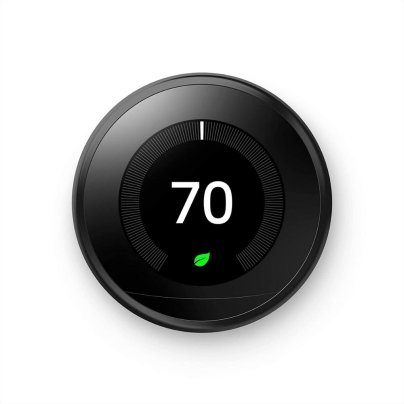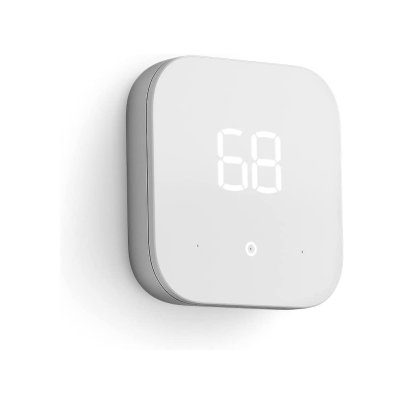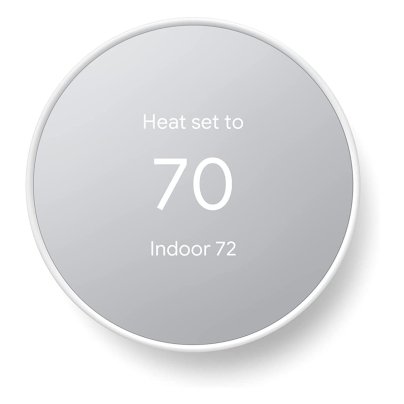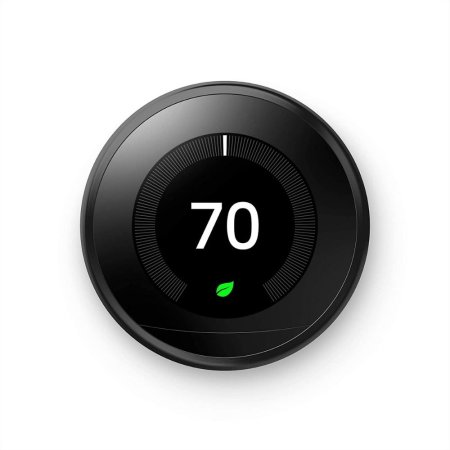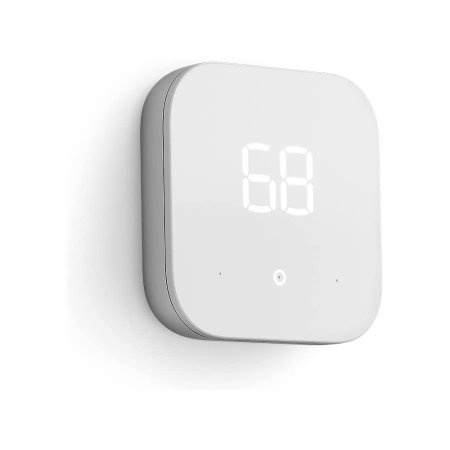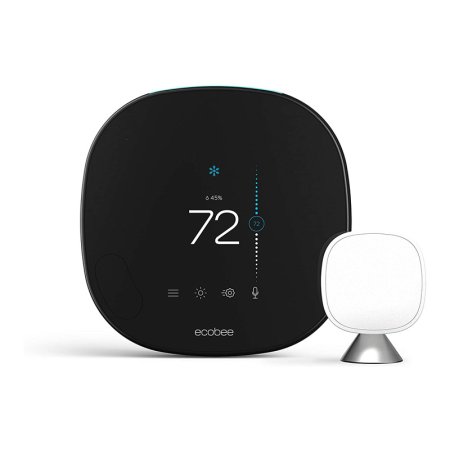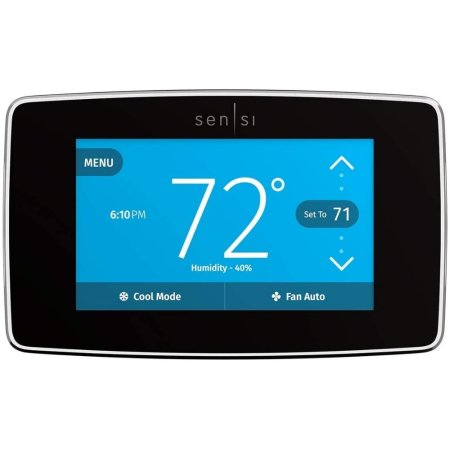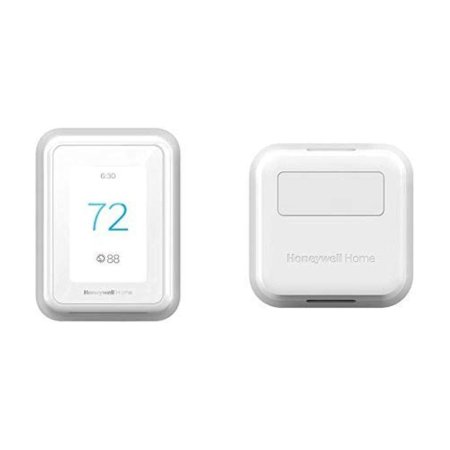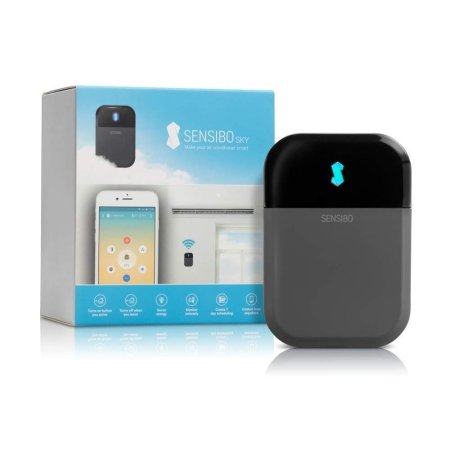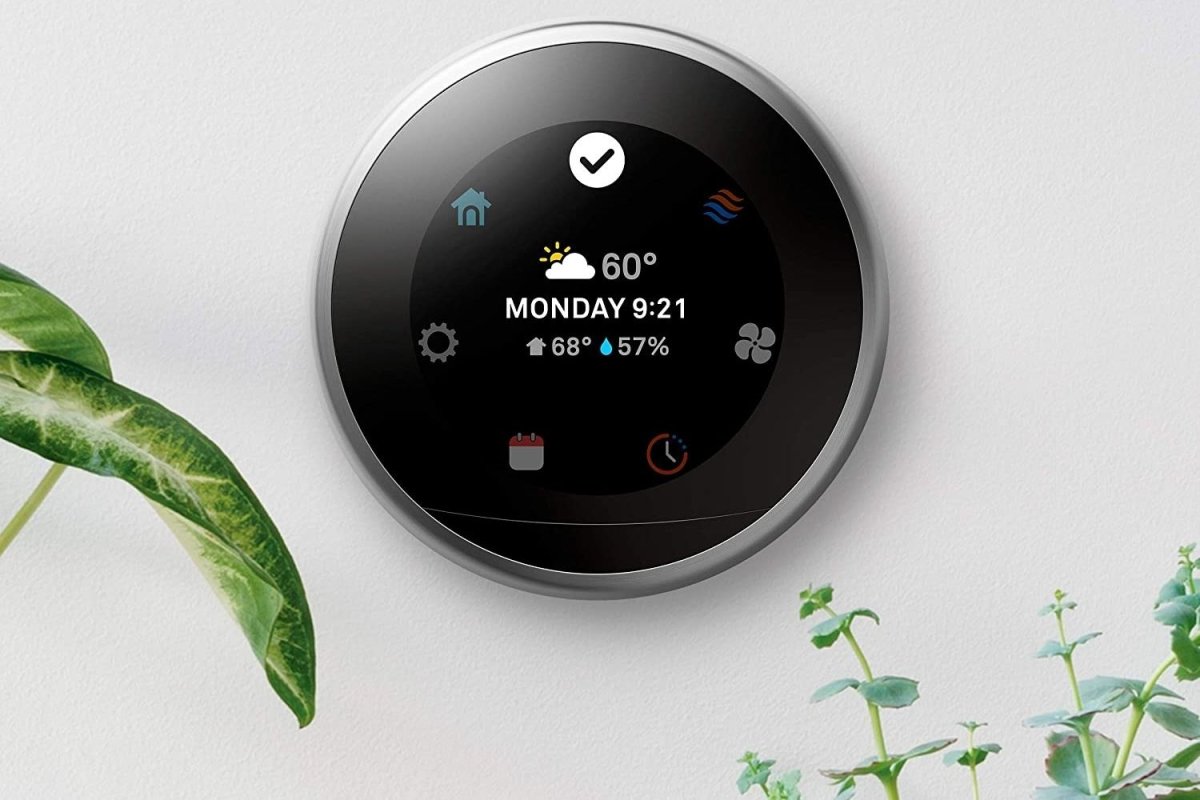
We may earn revenue from the products available on this page and participate in affiliate programs. Learn More ›
Smart thermostats, which connect with home automation systems, go beyond their programmable predecessors to offer a whole new level of residential temperature control with the added bonus of energy savings.
Today’s models all combine climate control with connectivity, but features vary from unit to unit. Some track and analyze your HVAC’s energy usage, monitor humidity, and notify you when it’s time to change the air filter. Others sense when you are at home and automatically adjust the temperature accordingly.
The best smart thermostat for any home is one that offers ample control to heat or cool a home as needed. With the right unit, you could save 20 percent or more on your utility bills. Read on for shopping tips and recommendations for the best smart thermostats on the market.
- BEST OVERALL: Google Nest Learning Thermostat
- BEST BANG FOR THE BUCK: Amazon Smart Thermostat
- BEST MID-RANGE: Google Nest Thermostat
- BEST VOICE CONTROL: ecobee SmartThermostat
- BEST TOUCH SCREEN: Emerson Sensi Touch Wi-Fi Smart Thermostat ST75
- BEST LARGE DISPLAY: Honeywell Wireless WiFi Thermostat TH9320WF5003
- BEST FOR MULTIPLE ROOMS: Honeywell Home T9 WiFi Smart Thermostat + 2 Sensors
- BEST FOR AIR CONDITIONER: Sensibo Sky – Air Conditioner Controller
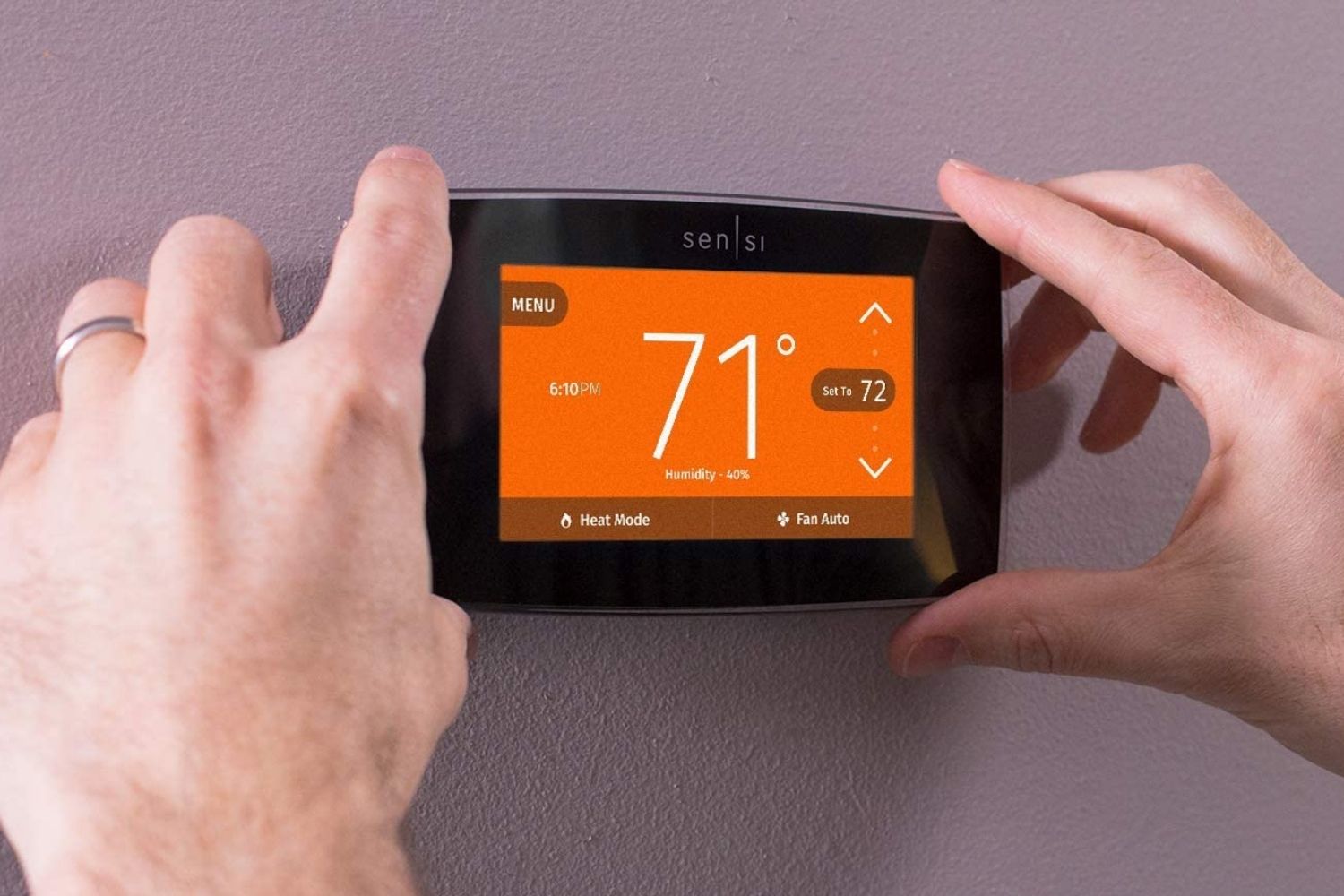
Before You Buy a Smart Thermostat
Smart thermostats offer energy savings in a simple set-it-and-forget-it device. Say goodbye to middle-of-the-night trips down the hall to fiddle with the thermostat because you’re too hot, too cold, or trying to save a few bucks. You can adjust a smart thermostat from anywhere, even while you’re on vacation a thousand miles away.
While smart thermostats offer convenience and conserve energy, they’re not for everyone. A smart thermostat requires a Wi-Fi network to operate and a bit of tech savvy (or a professional) to install it. If you decide to buy a smart thermostat, keep the following factors and features in mind so you can make an informed purchase.
How We Chose the Best Smart Thermostats
We researched the most sought-after smart thermostats in their respective categories and discovered that the best models are determined by their connectivity, size, voice control capability, and other special features included by select brands.
The above models can connect to Google Home, Amazon Alexa, SmartThings, Apple HomeKit, and Wink to be compatible with your home’s current smart home system. Many are compact enough to fit on a wall or shelf without taking up space and most are easy to install without professional help. Some of these smart thermostats also come with room sensors, voice control, and intuitive control panels for ease of use and convenience.
Our Top Picks
The best model for your home will be easily programmable and compatible with your HVAC system and other smart home technology. While each model has its advantages, any of the following top-rated thermostats would be an asset in most homes.
Best Overall
Google Nest Learning Thermostat
Pros
- Learns heating and cooling preferences over time
- User-friendly display is easy to read and adjust
- Attractive and modern rounded design
- Optional room sensors for better temperature monitoring (not included)
Cons
- Additional room sensors must be purchased separately
- More expensive than many other smart thermostats
Product Specs
- Price: $$$
- Works With: Google Home, Amazon Alexa, SmartThings
- Voice Control: Requires compatible smart device
- Room Sensors: Available separately
One of the most popular smart thermostats available, the Google Nest Learning thermostat integrates with Google Assistant and Amazon Alexa and syncs with other Nest devices for complete smart home integration. When you perform repetitive tasks, such as turning down the heat at bedtime and turning it up the next morning, the Nest thermostat learns and remembers your choices and begins changing its settings automatically for you.
The Google Nest Learning thermostat also features occupancy sensing and geofencing (sensors sold separately). This system stands out from the pack for its easy setup, high-resolution screen, and impressive ability to learn the patterns and preferences of household members.
This Nest thermostat allows users to monitor multiple rooms with temperature sensors (available separately). The device operates on either a rechargeable lithium-ion battery or by connection to a C-wire.
Read our full review:Google Nest Learning Thermostat
Get the Google Nest Learning smart thermostat at Amazon, The Home Depot, Best Buy, or Lowe’s.
Best Bang for the Buck
Amazon Smart Thermostat
Pros
- Very affordable yet still a feature-rich option
- Reliable learning feature makes adjustments based on your location and behavior
- Sleek and clean look
Cons
- Limited smart system compatibility; works with Amazon Alexa devices only
Product Specs
- Price: $
- Works With: Amazon Alexa
- Voice Control: Requires compatible smart device
- Room Sensors: N/A
Those looking for a feature-rich but affordable thermostat should check out the Amazon Smart Thermostat. Though compatible with Amazon Alexa devices only, this wallet-friendly choice packs in some excellent features. On top of the basics, including a remote, voice control, usage monitoring, and scheduling, it offers a learning feature.
The learning feature monitors your comings and goings to create “hunches” to adjust the thermostat based on your behaviors and phone location. While this feature doesn’t measure up to the learning capabilities of Google Nest’s Learning Thermostat, the affordable price reflects the difference.
Amazon’s thermostat comes in a simple and modern design with a minimalist touchscreen display. The Alexa app offers remote access to more controls and usage information.
Get the Amazon smart thermostat on Amazon.
Best Midrange
Google Nest Thermostat
Pros
- Easy installation; excellent option for DIYers
- Packed with features that are simple to use
- Several color options
Cons
- Limited on-board controls
- Not compatible with Nest temperature sensors
Product Specs
- Price: $$
- Works With: Google Home, Amazon Alexa, and SmartThings
- Voice Control: Requires compatible smart device
- Room Sensors: N/A
Google’s Nest thermostats have pioneered the smart thermostat space. Google’s Nest Thermostat serves as the brand’s basic and affordable alternative to the Nest Learning Thermostat.
The Nest thermostat lacks a touchscreen display and the learning features of the Nest Learning thermostat, but comes at a lower price. For its entry-level price, it boasts an excellent array of features packed into a sleek body that comes in a range of colors.
Google’s basic thermostat supports geofencing, occupancy sensing, scheduling, routines, voice control, and monitoring features so you can take advantage of smart features and savings on your electric bill. As an added bonus, this easy-to-install smart thermostat does not require a C-wire in some homes, which makes it an excellent option for DIYers.
Get the Google Nest smart thermostat at Amazon, The Home Depot, or Best Buy.
Best Voice Control
ecobee SmartThermostat
Pros
- Built-in smart speaker features Alexa voice control; no need for an additional external speaker
- Robust control and monitoring options
- Includes a room sensor and the option to add up to 32 rooms
Cons
- Pricey compared to many other smart thermostat options
Product Specs
- Price: $$$
- Works With: Google Home, Amazon Alexa, Apple HomeKit, SmartThings
- Voice Control: Yes
- Room Sensors: 1
Ecobee’s SmartThermostat with Voice Control comes with a built-in smart speaker, which eliminates the need for an external smart speaker to control it. With Alexa built in, the thermostat offers all of Alexa’s usual features, including music streaming and control of other devices in addition to HVAC control. But, for users who prefer another smart system, Ecobee works with most other popular voice assistants, too.
Housed in a sleek glass touchscreen display, Ecobee’s SmartThermostat looks nice on any wall. If you prefer not to use voice controls, the Ecobee Smart thermostat offers numerous other modes of control: an intuitive on-board display, a smartphone app, and a web interface, which includes a view of extensive insights into your power usage.
To monitor multiple rooms, the Ecobee smart thermostat comes with one SmartSensor with the option to add up to 32 to keep tabs on every room in the house.
Get the Ecobee smart thermostat on Amazon or at Best Buy.
Best Touch Screen
Emerson Sensi Touch Wi-Fi Smart Thermostat ST75
Pros
- Compatible with the most popular smart home systems; more options than some other smart thermostats
- Large touch screen panel; easy to use even for those less comfortable with technology
- Intuitive on-board and app controls
Cons
- Lacks occupancy sensing
- Requires a C-wire for installation, which might be better left to a professional
Product Specs
- Price: $$
- Works With: Google Home, Amazon Alexa, Apple HomeKit, SmartThings, and Wink
- Voice Control: Requires compatible smart device
- Room Sensors: N/A
In addition to both iOS and Android connectivity, Emerson’s smart thermostat gives users easy control of all thermostat functions via a large high-definition touch screen panel. It requires a C-wire for operation and integrates with many smart home systems, including Alexa, HomeKit, Google Assistant, and Wink.
Emerson’s Sensi Touch sends smart alerts to users’ smartphones when the home reaches humidity or temperature extremes. Other helpful features include energy usage reports, 7-day scheduling, and geofencing. The model does not offer occupancy sensing.
Get the Emerson smart thermostat at Amazon, The Home Depot, or Best Buy.
Best Large Display
Honeywell Wireless WiFi Thermostat TH9320WF5003
Pros
- Easy-to-read touchscreen display shows a wealth of information
- Multiple data readouts
- Monitors indoor and outdoor humidity levels
- Optional energy-saving mode
Cons
- May require a professional for C-wire installation
Product Specs
- Price: $$
- Works With: Google Home and Amazon Alexa
- Voice Control: Requires Amazon Alexa
- Room Sensors: N/A
With the large digital display on this model, users can easily read the temperature from across the room. The display also shows the day, date, time, outdoor temperature, and indoor and outdoor humidity levels.
Users may program the thermostat, either directly on the display or through the smartphone app, to follow a 7-day schedule, which saves money and energy. Save even more with the optional energy-saving mode.
This smart thermostat syncs with smart-home systems, including Google Home and Alexa. It requires a C-wire and a Wi-Fi network for operation.
Get the Honeywell TH9320WF5003 smart thermostat at Amazon, The Home Depot, Best Buy, or Build.com.
Best For Multiple Rooms
Honeywell Home T9 WiFi Smart Thermostat + 2 Sensors
Pros
- Excellent system for monitoring multiple rooms
- Comes with 2 room sensors with the option to purchase additional sensors
- Sensors measure and can adjust based on temperature, humidity, and occupancy
Cons
- Some feel the design is less attractive than other smart thermostat options
Product Specs
- Price: $$$
- Works With: Google Home, Amazon Alexa, SmartThings, and Apple HomeKit
- Voice Control: Requires compatible smart device
- Room Sensors: 2
Sensors in multiple rooms help keep your home at an even temperature and eliminate hot and cold pockets in different areas of the home. The Honeywell Home T9 smart thermostat makes an excellent choice for monitoring and adjusting the temperature across several rooms.
This thermostat comes with two sensors that monitor the room’s temperature, humidity, and occupancy. Users have the option to add additional sensors (sold separately). Temperature settings may target rooms based on occupancy or follow a programmed schedule.
Honeywell Home’s T9 also includes several features expected from smart thermostats, including remote and voice control (with a compatible smart system), geofencing, scheduling, and monitoring features.
Get the Honeywell Home T9 smart thermostat on Amazon or with 1 room sensor at The Home Depot, Best Buy, or Target.
Best For Air Conditioner
Sensibo Sky – Air Conditioner Controller
Pros
- Works with many individual AC units, including window and portable ACs
- Easy installation; DIY friendly
- Good geofencing and scheduling features help save on energy consumption and cost
Cons
- Only compatible with remote-controlled AC units
- Lacks on-board display or controls
Product Specs
- Price: $$
- Works With: Google Home, Amazon Alexa, and Apple HomeKit
- Voice Control: Requires compatible smart device
- Room Sensors: N/A
While most smart thermostats sync only with central HVAC systems, the Sensibo Sky air conditioner controller offers smart home syncing with any remote-controlled individual AC units, including mini-split ACs, window ACs, and portable AC units. Like other smart thermostats, this product needs a Wi-Fi network for operation.
The thermostat syncs with both iOS and Android devices and works with Alexa, Google Home, and Apple Siri systems. Sensibo’s smart thermostat does not require a C-wire, which makes installation fast and DIY-friendly. Once set up, users can take advantage of the smart geofencing and scheduling features to keep rooms cool and save on the energy bills.
Get the Sensibo smart thermostat on Amazon.
A Recap of Our Recommendations
- BEST OVERALL: Google Nest Learning Thermostat
- BEST BANG FOR THE BUCK: Amazon Smart Thermostat
- BEST MID-RANGE: Google Nest Thermostat
- BEST VOICE CONTROL: ecobee SmartThermostat
- BEST TOUCH SCREEN: Emerson Sensi Touch Wi-Fi Smart Thermostat ST75
- BEST LARGE DISPLAY: Honeywell Wireless WiFi Thermostat TH9320WF5003
- BEST FOR MULTIPLE ROOMS: Honeywell Home T9 WiFi Smart Thermostat + 2 Sensors
- BEST FOR AIR CONDITIONER: Sensibo Sky – Air Conditioner Controller
What to Consider When Choosing the Best Smart Thermostat
Smart thermostats range from around $125 to $500, but they are only as good as their features. Shopping for this tech can be confusing. Consider which of the following features are “must haves” or “don’t wants” before selecting a unit. If a thermostat is too complex to configure and operate, it won’t save you any money.
Occupancy Sensing
Some smart thermostats include remote sensors, which users install throughout the house, that detect when someone is in a room. When a sensor detects movement, the smart thermostat adjusts the temperature to a comfortable level.
Remote sensors work with standard HVAC systems and also with zoned HVAC systems that permit the heating of selective rooms. The majority of smart thermostats feature occupancy sensing. You may add a remote sensor (or several) for different rooms at an additional cost.
Geofencing
This GPS-based detection system saves on utility costs because it doesn’t start heating or cooling until you’re on your way home. Geofencing works through a downloaded smartphone app.
Users simply program a radius around their home—of, say, 3 miles—and when the smartphone enters the radius, it signals the smart thermostat to heat or cool the house in preparation for the user’s arrival.
Pro Tip: Don’t turn off your smartphone’s location services if the thermostat uses geofencing to turn the heat up and down. Leave the location on, and you won’t worry about coming home to a house that is either too hot or too cold.
Smart Home Integration
Smart thermostats integrate with popular home automation and voice assistant systems such as Google Home, Amazon Alexa, Apple Homekit, SmartThings, Wink, Vera, and Logitech Harmony. Integration into a smart home system often allows for voice control through digital assistants, like Alexa and Google Assistant. Some are compatible with only one or two systems, so before you buy a thermostat, make sure it works with your smart home system.
You control your smart thermostat through its corresponding downloadable smartphone app. Most apps come in iOS and Android versions, but not all of them do, so check before you buy. Some smart thermostats need only a smartphone for programming. Others need time to “learn” the residents’ habits to regulate the home’s temperature.
Display and Scheduling
Designed with ease-of-use in mind, many smart thermostats include user-friendly onboard displays that control some or all of their features. All smart thermostats have compatible apps that offer the full range of controls, but on-board controls may offer only a selection of the thermostat’s features..
Some smart thermostats have a small display to view and control basic functions, while others have large, touchscreen displays to adjust a range of settings. When choosing a thermostat, consider if you prefer controlling the thermostat from your phone or if you’ll take advantage of robust on-board controls.
While apps and displays give you control in the moment, programming options like scheduling allow you to set the thermostat and forget about it. Pretty much all smart thermostats come with a schedule feature, which adjusts the temperature automatically throughout the day according to your chosen presets.
Power Requirements
Smart thermostats require more electricity than either manual or programmable thermostats to power their network connections and GPS functions. This means the model you select may require a common wire (also known as a C-wire) that runs from the thermostat to the HVAC system. Some thermostats come with a power extender kit (PEK) as an alternative to a C-wire.
Pro Tip: If your home is less than 10 years old, it probably already has a C-wire. If not, you’ll need to have one installed or purchase a smart thermostat that doesn’t require a C-wire to function.
Installation
While many smart thermostats need only a confident DIYer to complete installation, those who are unsure about working with wiring should opt for professional installation. Before buying a smart thermostat, double check its compatibility with your HVAC system so you don’t run into any hiccups during setup.
Many smart thermostats require a C-wire for installation. If your current system does not have a C-wire, consider hiring an electrician or HVAC technician to install one (or choose a thermostat that doesn’t require one). Once the smart thermostat is installed, setup is relatively straightforward and involves connecting to the home WiFi and corresponding app to get the thermostat up and running.
The Advantages of Owning a Smart Thermostat
Convenience and reduced utility bills top the list of reasons to install a smart thermostat, but those are not the only reasons. Here’s a few more:
- Users turn the heat (or AC) up or down remotely.
- The device programs the HVAC system to run less when no one’s home for added energy savings.
- Some smart thermostats provide energy use tracking and analysis to help users understand where loss occurs.
FAQs
Smart thermostats make controlling your home’s heating and cooling system a breeze. A Wi-Fi thermostat allows you to adjust the temperature from anywhere from your smartphone, whether you’re on the couch or vacationing on the beach. Those who want more info on shopping for and using a smart thermostat for the first time should check out answers to these common questions.
Q. How does a smart thermostat work?
A smart thermostat connects to the home’s wireless network to relay information and allow the user to control the heating and cooling system remotely or by voice commands.
Q. Can I make my thermostat smart?
Theoretically, it may be possible. Manufacturers are producing modules and transceivers that can make certain types of existing thermostats compatible with smart home systems. This technology is still in its infancy, however, so you might be better off buying an actual smart thermostat for now.
Q. Do you need Wi-Fi for a smart thermostat?
Yes. Smart thermostats must connect to the Wi-Fi in a home in order to communicate with the user’s smartphone.
Q. Does a smart thermostat still work during an Internet outage?
The features that make the thermostat “smart,” such as geofencing, voice command, and control through a smartphone app, won’t work when the Internet is out. But, you can still control the thermostat manually directly on the unit.
Q. Can you install a smart thermostat yourself?
If your home already has a C-wire, replacing an existing thermostat with a smart one is relatively simple and most likely a DIY project. If the house doesn’t have a C-wire, a professional should install one.
Q. Is replacing a thermostat easy?
Replacing a standard thermostat with a smart thermostat may be beyond most DIYers’ scope because smart thermostats often require the addition of a C-wire that runs from the thermostat to the HVAC system. This wire carries electricity and should be installed by an electrician. However, a few models come with an alternate power adapter, and these are simpler to install.
